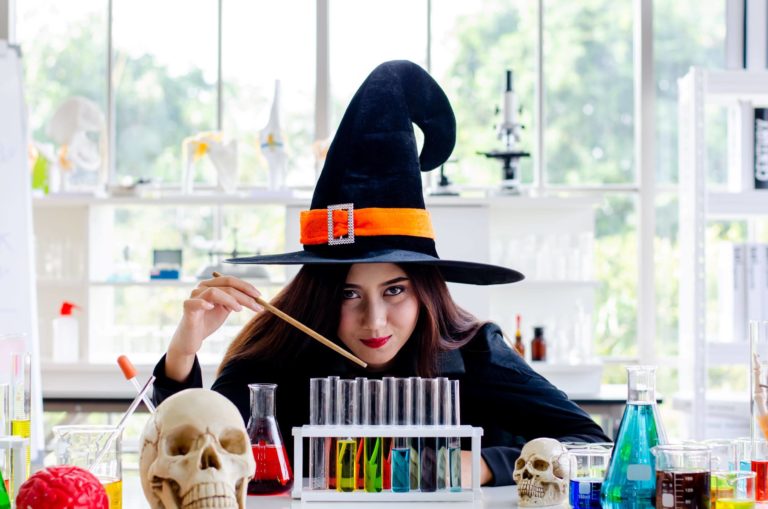It’s Halloween time which means it’s time to get ready for some spooky science experiments, and “spook-tober” is the perfect month to help students release their inner mad scientist and conduct a few memorable experiments. Get your pumpkins and dry ice ready for some bubbling science experiments for high school students they won’t soon forget.
Pumpkin Power
Did you know that you can turn a pumpkin into a battery? For this experiment, students will harness the power of pumpkins to see how many volts it can get. The more pumpkins you use, the more power you get, so challenge students to try it with multiple pumpkins after this experiment.
The objective of this experiment is to show students how fruit can turn into a battery.
Materials you’ll need:
- Two pumpkins
- Multimeter
- Alligator clip
- Zinc strips, galvanized screws, or nails
- Copper strips or thick copper wire
- Safety goggles
Steps for experiment:
- Gather materials and place them on a workbench or table.
- Stick a copper strip and zinc strip on opposite sides of each pumpkin. If you don’t have the strips, you can use galvanized nails and copper wire which you can find for less than a dollar at a hardware store.
- Connect the copper from one pumpkin to the zinc in the other pumpkin with the alligator clip.
- Connect the black lead from the multimeter to the other remaining zinc strip and the red lead to the second remaining copper strip.
- Turn the multimeter to the “V” with the line above to see what the voltage measures. It should measure at least 1.5 volts or higher. If it doesn’t, then check that everything is connected correctly. Note: you may get a different voltage reading depending on the items you used and the size of your pumpkins.
The science behind this experiment is that pumpkins have acidic juices that help to transport electrical energy. The zinc ions leave behind electrons that travel to the copper, and this movement then creates electricity.
Erupting “Vomiting” Pumpkin
If you’re looking for a Halloween science experiment that students can do remotely, then the erupting pumpkin volcano is the way to go. This is also the perfect experiment for high school students to do for their younger siblings or neighbors because young children will a kick out watching a “vomiting” pumpkin.
Since this is a messy experiment, it’s best to go outdoors. It’s also wise to instruct students to use their rotting (already carved) pumpkins before they get thrown away, so if they’re doing the experiment from home, they don’t need to buy new pumpkins.
The objective of this easy science experiment is to show students a simple chemical reaction they can do at home.
Materials you’ll need:
- Carved Pumpkin
- Food coloring
- Dish soap
- Measuring cup
- Tablespoon
- Small cups
- Warm water
- Dry yeast
- Hydrogen peroxide
- Safety goggles
Steps for experiment:
- Gather materials and go outside.
- Open the top of the pumpkin and pour one tablespoon of dish soap.
- Drop about 10 drops of food coloring (the actual amount is up to you, depending on the color you want).
- Pour in a half of cup of hydrogen peroxide.
- Mix one tablespoon of dry yeast and three tablespoons of warm water for about one minute.
- Carefully pour the mixture into the hole and watch how the pumpkin starts to foam.
Experiment with different amounts of ingredients to see how the foam changes.
The science behind this experiment is this: the pumpkin foams because of the yeast. When you add the warm water, the yeast gets ready to work. The yeast then reacts with the hydrogen peroxide, strips off the oxygen atoms, and turns the hydrogen peroxide into water. Then the hydrogen peroxide turns into water and oxygen gas. When the oxygen gets released by the yeast, it bubbles into the dish soap and makes foam. The speed of the reaction then pushes the foam out of the holes of the pumpkin, making it an erupting or “vomiting” pumpkin.
Spooky Halloween Punch
When it comes to Halloween, elementary students are the ones who have the parades and parties, but what about high school students? They, too, would like to celebrate Halloween and partake in some fun festivities. This experiment is the perfect way to add spooky excitement into your high school science class.
This experiment aims to show students the process of sublimation – the transition of a substance from a solid state to a gas state.
Materials you’ll need:
- Punch bowl
- Punch (any type of liquid refreshment)
- Heavy gloves
- Dry ice
- Safety goggles
Steps for experiment:
- Fill the punch bowl with the liquid refreshment about halfway (you’ll need room in the bowl for the “fog” to fill the rest of the bowl as well as run over the sides of the bowl).
- Put on goggles and heavy gloves and place a few pieces of dry ice into the punch bowl. You will see the effect begin immediately, but let it sit and bubble for a few minutes.
- It’s advised to wait until the dry ice is gone before serving the punch to students but if you decide to serve the punch, use a strainer so no one accidentally gets any dry ice into their glass.
The science behind this experiment is this: dry ice is frozen carbon dioxide. The temperature of dry ice is -109.3°F (-78.5°C). Dry ice does not melt into a liquid as its temperature rises; it changes directly into a gas. This process is called sublimation.
All of these science experiments are designed to be under the supervision of an adult to ensure safety. Please make sure students are wearing safety goggles and use precaution when conducting each experiment.




